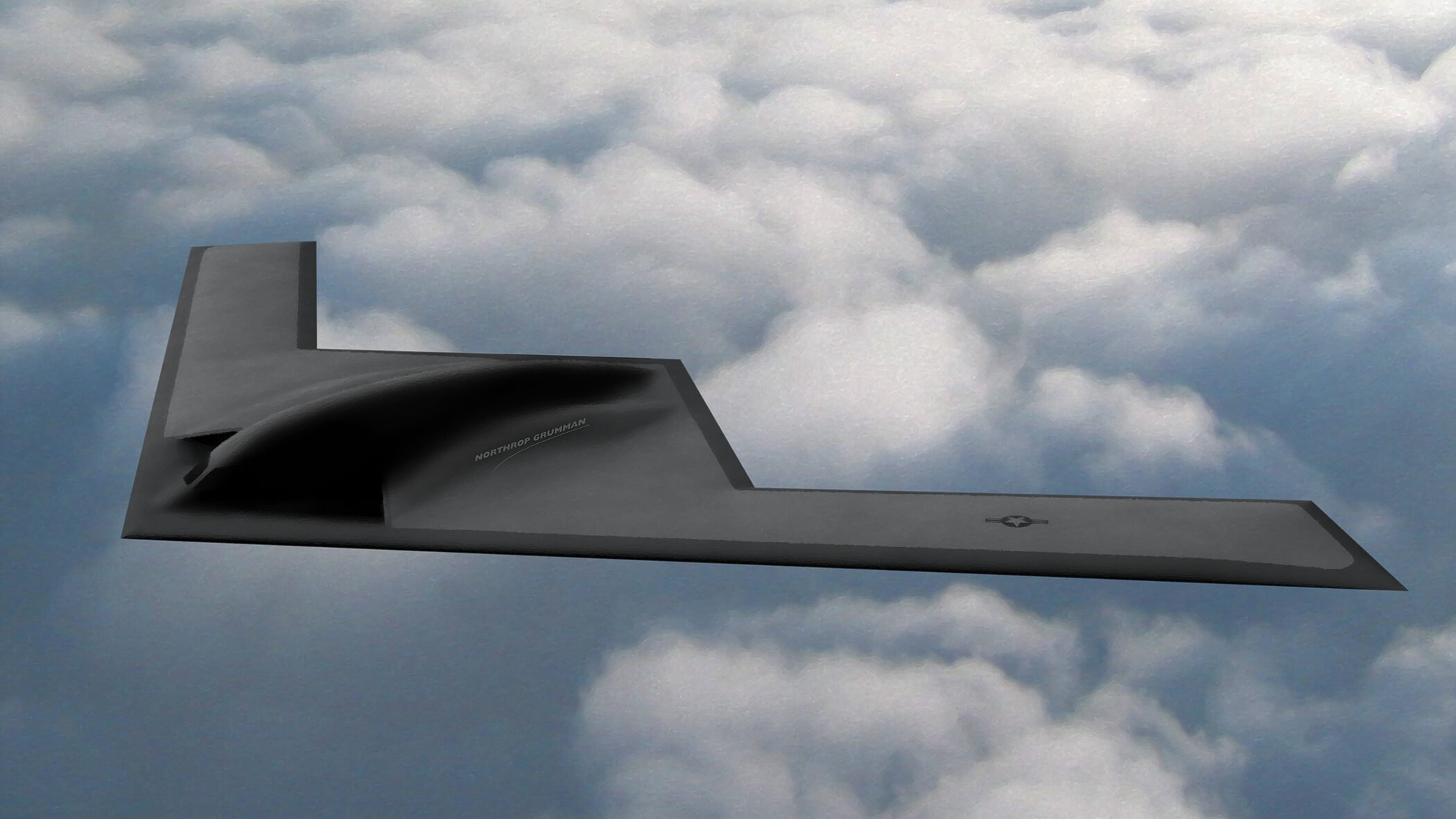
An artists rendering of the B-21 flying. (Northrop Grumman)
PALMDALE, Calif. — Tonight’s roll out of the Air Force’s newest stealth bomber, the B-21 Raider, has been a long-awaited event for military observers and aviation geeks around the globe eager for any sneak peek at the highly classified aircraft designed to usher in a new era of long range precision strike.
About 600 people scored a “golden ticket” to the ceremony to watch in person as the B-21 is finally unveiled and towed (at least partially) out of its hangar to be viewed by the public for the first time. That list of lucky attendees includes Defense Secretary Lloyd Austin, Air Force Secretary Frank Kendall, and an array of House and Senate lawmakers.
And while the event is sure to be full of pomp and circumstance, big questions remain: Exactly how much of the B-21 will prime contractor Northrop Grumman reveal? And, as importantly, will it be more than meets the eye anyway?
“When people see the exterior of the B-21, it will be very similar to the B-2,” said Northrop CEO Kathy Warden in an interview with Breaking Defense. “The real differences are inside of the platform, because you can think about how much digital technology has progressed since the time we built the B-2 and the time we built the B-21.”

Kathy Warden, president and chief executive officer of Northrop Grumman Corp., speaks during an interview at an Economic Club of Washington event in Washington, D.C., U.S., on Wednesday, May 4, 2022. Northrop Grumman will see a surge of as much as $59 billion in research and procurement spending over six years for its two top defense programs if the U.S. Air Force’s new spending plan is realized. Photographer: Al Drago/Bloomberg via Getty Images
Warden said the B-21’s capability is “significantly greater on all the requirements that the Air Force had around stealth — meaning low observability — [and] the range of the platform.”
“But there also is a more modern approach to the open systems architecture of the B-21 that will make it easier to upgrade over time and ways that we’ve manufactured the B-21 compared to the B-2 that will also make it far more sustainable in terms of the exterior and the hardware of the platform,” she said.
Warden called the roll out “a momentous occasion” that will finally give the 8,000 people working on the program — which spans 400 suppliers in 40 states — a chance to show Americans what their tax dollars have been paying for. (The Air Force projects the average procurement unit cost of the B-21 to be $692 million in 2022 dollars per aircraft, a sum that includes the bomber itself as well as training, spares and support equipment.)
“It’s really a way to recognize the thousands of people who have been working on the program from the Air Force, from Northrop Grumman, from our key suppliers, who during the pandemic really did sacrifice a good deal to come to our factory and keep program on track,” she said.
But it’s also a risk to exhibit one of the world’s most advanced stealth aircraft publicly — a lesson Northrop learned the hard way when it rolled out the B-2 on Nov. 22, 1988. That’s when legendary Aviation Week reporter Michael Dornheim flew a Cessna 172 over Northrop’s production facilities in Palmdale, capturing overhead photos of the B-2 that revealed important advances in stealth technology.
Northrop has been planning the B-21 rollout for months, and security will be of the utmost concern during today’s festivities. Attendees have been given strict guidance that prohibits taking smartphones into the event or shooting video during the ceremony. The B-21 will only be permitted to be photographed from a raised platform with cameras that meet lens requirements.
Although the Air Force acknowledges the existence of the B-21, the overwhelming majority of details about the classified program — including detailed cost data and information about the Raider’s new capabilities — have been kept secret in the hopes of preventing China or Russia from gaining an edge against the new bomber. Currently, the only images available of the aircraft are digital renderings that depict the B-21 as a triangular flying wing very similar in appearance to the B-2, with few distinguishing features apparent in the illustrations.
The Air Force plans on buying at least 100 B-21s over the lifespan of the program. The Air Force requested $5 billion for B-21 in fiscal 2023, including $1.7 billion in procurement funding. However, the service will not disclose how many bombers that will buy.
Northrop currently has six Raiders in production at its facilities at Air Force Plant 42 in Palmdale. The B-21 that will be featured in today’s ceremony is the first test article, which is currently moving through ground tests and is slated to fly sometime next year, Warden said.
Northrop has touted the B-21 as the “world’s first sixth-generation aircraft” created using agile software development and digital engineering practices that allow it to model the design and sustainment of the aircraft with higher level of precision, which makes it easier for its suppliers to repeatedly produce parts that meet strict technical specifications, Warden said.
“Then when we get parts in from them, we are seeing the aircraft come together much more smoothly than we did on the B-2,” she said. “That level of integration with our suppliers has helped reduce risks in the development of this program. And that applies to the test articles that are in production today … but will also apply as we transition into production going forward.”






















